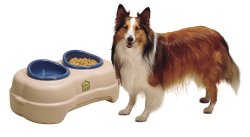|
Start here if you're looking for a raised dog feeder...
In this article I explain the benefits of a raised dog feeder. I also describe several things to consider when making your purchase of an elevated dog feeder. Taken as a whole, this article will help you make the perfect decision on your dog’s feeder.  Raised Dog Feeder Benefits I’m sure you love your dog. You want to pamper it and take care of it. That includes providing him with good nutrition and a simple eating environment. A good elevated dog feeder is exactly what you need because it makes you know that you’re helping your pet. Let’s take a look. Raised bowls and dishes provide these four important benefits: 1. It promotes better posture. Dogs have postures to protect too, especially the older ones. Eating without the need to lean forward and down is essential to keep the dog's bones frame structure in tiptop condition most importantly as they get older. 2. It promotes better digestion. If your dog eats from a raised dog feeder, the process of digestion is going to be smoother. The food moves from the mouth to the stomach in a quicker and easier manner. There’s less chance of choking and complications. 3. It reduces stress on your pet's joints. If your dog does not need to lean down all the time, the tension on its front limbs is lessened. Obviously this improves your dog’s quality of life.
Buying a Raised Dog Feeder Now that we’ve covered the benefits of elevated dog feeders, let’s take look at buying a raised feeder. Keep your needs in mind and obviously keep track of what your dog needs. Think about your requirements and benefits as you review this list. In buying raised dog feeders, here are some things you should consider: 1. The dog feeder's height. It is believed that the perfect height for feeders is six inches below the dog's front shoulder. If your dog is relatively small and six inches seem to be too low for it, four inches should do. 2. The dog feeder's capacity. This is needed just to be sure that you feed your dog in one go. You can try to measure his current food bowl. Fill it with water and see how much your dog can consume. Currently available raised feeder bowls ranges from 2 to 16 cups in volume. 3. The construction and form of the dog feeder. The ideal feeder will be lightweight and is resistant to decay or rot. It should also have low thermal conductivity, which is ideal for times you have to serve oven-fresh food to your dog. It should also be easy to clean and comes in good colors and textures that can easily be repainted, if needed be. 4. The material of the raised dog feeder. These bowls comes with the respective stands. Make sure that the construction is superb. Some manufacturers add a cross bar for further support. Some are made of good quality metal or hardwearing plastic. The material used is the critical determinant of durability.
5. The various functions of the elevated feeder. Raised dog feeders can come in a single to three-bowl feeders. Two-bowl feeders are ideal if you have two pets or if you rather serve food and water at the same time. Some are made especially for big dogs, while some can be customized according to your needs. Whichever the case, try to make sure that the one you are going to buy best matches the requirements of your pets. 6. The cost of the dog feeder. Prices can differ quite a bit, according to the capacity, the height, and the number of bowls. Customized raised dog feeders can cost higher than usual. The price can range from $30 to as much as $200. Just make sure that the price you are going to pay is reasonable for the value that you are going to get. 7. The availability of the product. There are products that can readily be shipped, especially the ones offered through the Internet. Some can be bought at regular pet stores. Still others can only be bought at specialty stores because they are custom made. These are the things that you need to know about buying a raised dog feeder. With this information, you now have a good idea what you need and why you need it. Good luck with your decision. Pet Food Dish Overview Home Page
Subscribe to the Pet Comfort Newsletter
|



